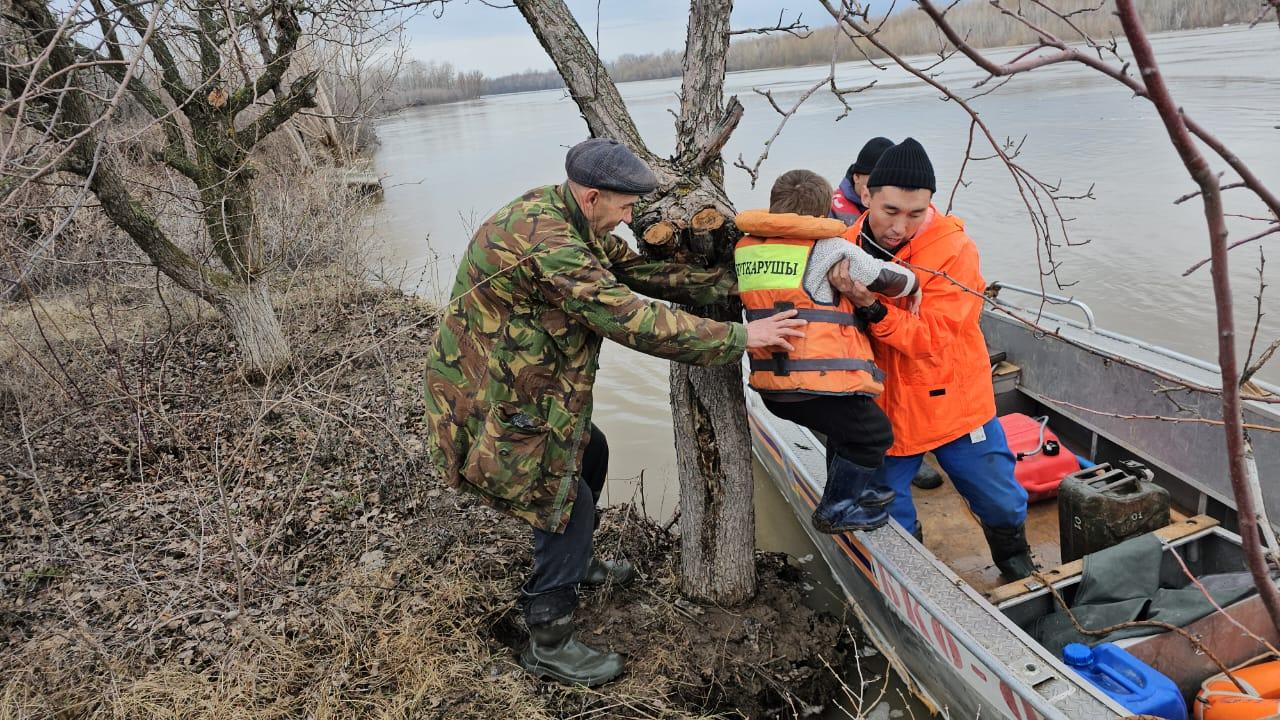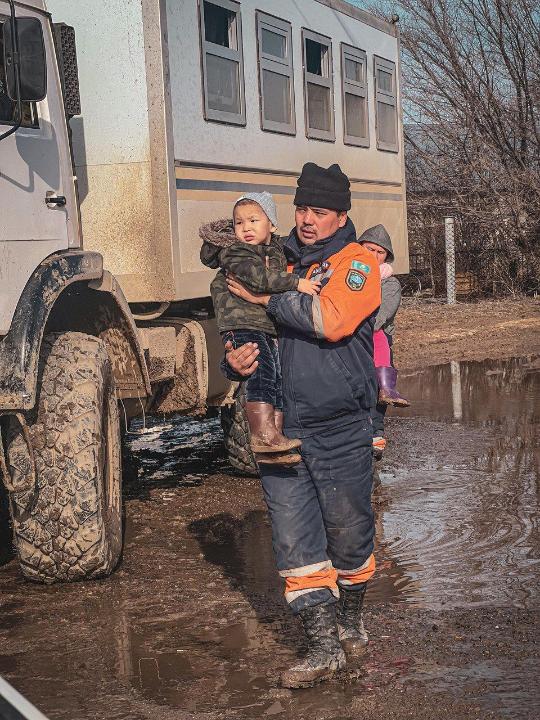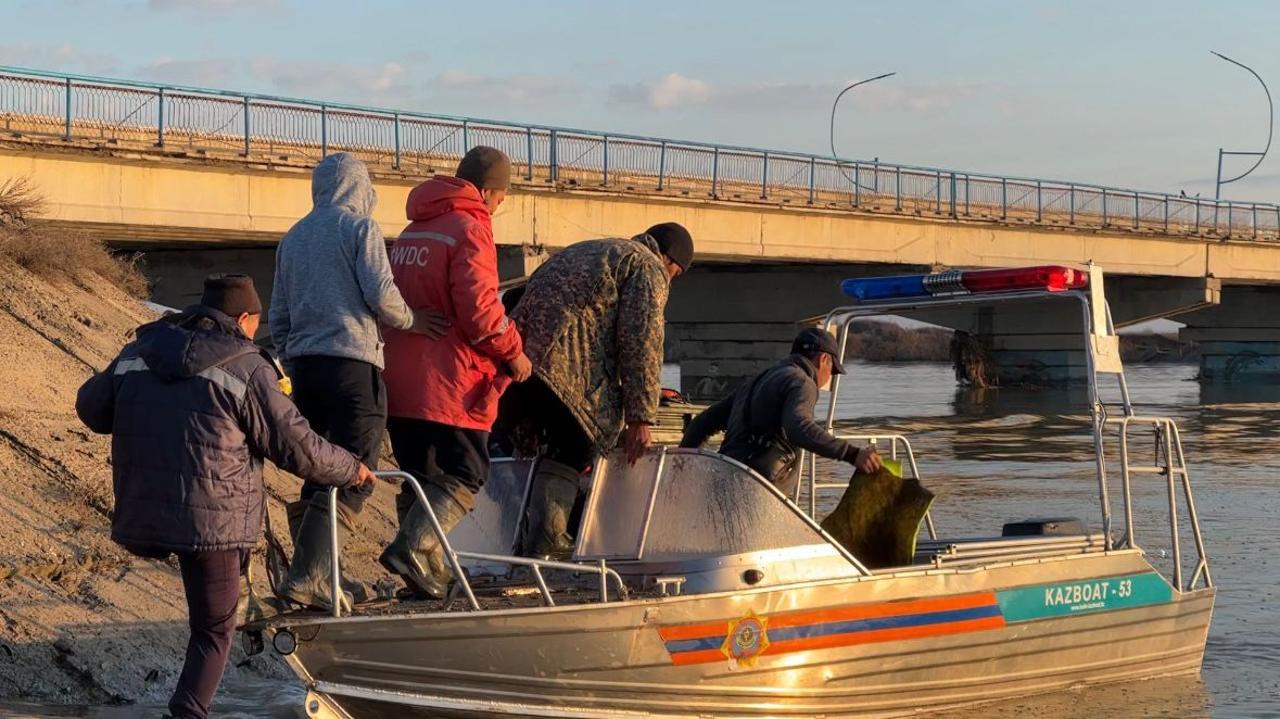ASTANA – According to the latest data from the Ministry of Emergency Situations, 75,982 people, including 18,681 children, have been rescued and evacuated across the country due to massive floods. This was announced by Saipash Erasyl, a senior officer of the Civil Defense and Military Units Committee, during an April 8 briefing at the Central Communications Service.

Photo credit: Ministry of Emergency Situations
The Akorda press service said that on April 8, President Kassym-Jomart Tokayev spoke by telephone with the akims (mayors) of the Akmola, Aktobe, Kostanai, and North Kazakhstan Regions to learn about the flood situation and the measures taken to contain the natural disaster and mitigate its consequences.
According to officials, the situation is under control, and there are sufficient resources and personnel to combat the natural disaster.

Photo credit: Ministry of Emergency Situations
At the President’s directive, a government team led by Prime Minister Olzhas Bektenov, who also heads the National Headquarters, was dispatched to the regions affected by the flood.
As of today, a state of emergency remains in 10 regions of Kazakhstan: Akmola, Aktobe, Atyrau, Karagandy, Kostanai, Pavlodar, West Kazakhstan, North Kazakhstan, Abai, and Ulytau. Currently, 15% of the country is covered in snow, with nearly 40% of the northern, eastern, and central regions under snow cover.
Evacuation of residents
According to the latest data from the Ministry of Emergency Situations, 75,982 people, including 18,681 children, have been rescued and evacuated from the emergency zones since the floods began.

Photo credit: Ministry of Emergency Situations
Approximately 7,203 people, including 2,794 children, are staying in temporary accommodation centers. Over 7 million cubic meters of meltwater were pumped out, and nearly 993,000 sandbags were laid.
Water has been diverted from over 1,739 residential buildings and 1,743 courtyard areas. Rescue efforts involve 16,375 people, more than 1,600 pieces of equipment, 377 water pumping equipment, 81 watercraft, and 15 aircraft.
Today, 3,745 private residential buildings and 421 courtyard areas in seven regions remain flooded: Atyrau, Aktobe, Akmola, Kostanai, East Kazakhstan, North Kazakhstan, and Pavlodar Regions.
Compensation will be paid to affected citizens after the conclusion of an independent audit.
According to the Defense Ministry, from March 27 to April 7, some 2,357 military personnel, 112 units of military equipment, ten helicopters, and four units of military transport aircraft were involved in the efforts.
Hydrometeorological Service forecast
According to data from the Kazhydromet National Hydrometeorological Service on April 8, the country’s northwest, north, and center are expected to experience precipitation at night and rain during the day. Rainless weather is expected only in the southwest and southeast of the country.

Photo credit: Ministry of Emergency Situations
Due to the forecast of increased air temperatures and rain, water levels and outflows are expected to increase further in the Aktobe and Akmola Regions from April 7 to April 10.
Current situation in regions
At the time of writing, the flood situation in the Akmola Region is challenging. Meanwhile, local operational measures prevented the flooding of 2,000 houses in 25 settlements where more than 5,000 people live. Over 18,000 heads of livestock were evacuated.
The situation in the Kostanai Region is stable yet dangerous. Rescue work continues in Kostanai due to rising water levels in the Tobol River. More than 8,300 people, including nearly 1,700 children, have been evacuated.
In the North Kazakhstan Region, the peak of high water in Petropavlovsk is expected at the end of April. The flood situation is constantly monitored.
The threat of flooding remains in the Aktobe Region, and people are being evacuated. Work is ongoing to pump out meltwater and place sandbags.
A state of emergency was introduced in the Atyrau Region on April 7. Intense work continues on bank protection with 45,900 bags and 174,300 tons of inert material placed.
The local emergency situation was lifted in the village of Zhalauly in the Pavlodar Region. Local forces could not drain water from the settlement for almost two weeks.
Owing to preventive measures, the Karagandy Region has managed to avoid the destructive consequences of flooding. Despite the significant volume of incoming water, flooding of populated areas is minimal.
The situation in the East Kazakhstan Region is stable. According to local akimat (administration), the first wave of floods in the region passed without consequences thanks to preventive measures. However, heavy rains are expected in the region.
Volunteers
More than 25,000 volunteers are involved in addressing the aftermath of floods nationwide. Volunteers provide the affected population with hot food, warm clothing, and sleeping places. According to the National Volunteer Network, work is underway to provide medications to the affected residents. In addition, volunteers are clearing snow in populated areas and taking care of elderly people.
To date, more than 550 tons of humanitarian aid have been collected throughout the country. Foreign countries have also expressed support and sent relief supplies.
The Ministry of Emergency Situations has called on citizens to be extremely careful, strictly observe safety measures during the flood period, and only leave their homes and evacuation centers if permitted.
On April 6, President Kassym-Jomart Tokayev addressed the nation amid the devastating floods.


